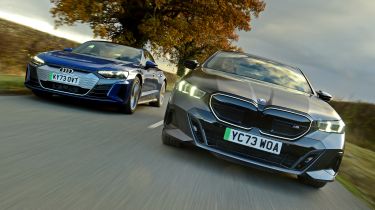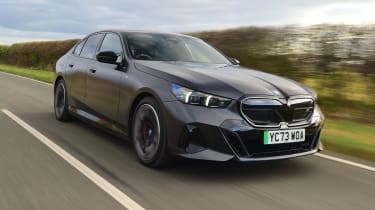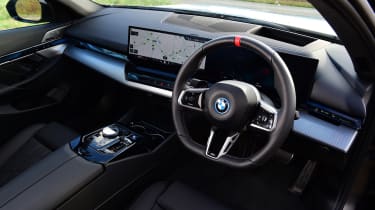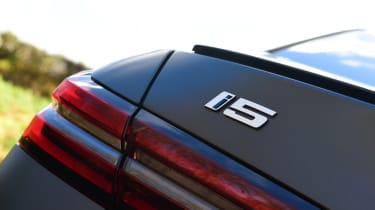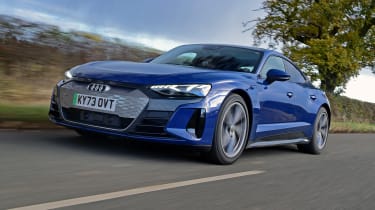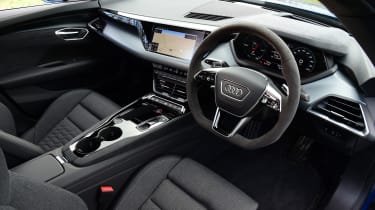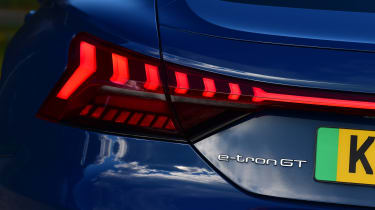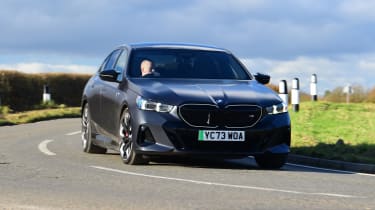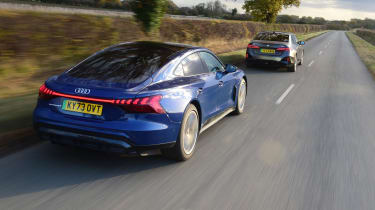Audi e-tron GT vs BMW i5: executive EV powerhouses go head-to-head
BMW’s flagship all-electric executive saloon faces up to Audi’s established rival
BMW and Audi have provided the main protagonists for some of the biggest executive car showdowns over the last few decades. Now, the pair find themselves fighting on a new stage, thanks to the release of BMW’s all-electric i5 M60 xDrive. At £97,745, it’s right in the crosshairs of the Audi e-tron GT. Both are high-performance yet practical EVs, that on the face of things go about things quite differently. But as we’ll come to see, this is another Munich vs Stuttgart fight that goes right down to the wire.
| BMW i5 M60 xDrive | Audi e-tron GT quattro | |
| Price: | £97,745 | £86,585 |
| Powertrain: | Two electric motors, 593bhp, 81.2kWh battery | Two electric motors, 523bhp, 93.4kWh battery |
| 0-62mph: | 3.8 seconds | 4.1 seconds |
| Test efficiency: | 3.1 miles/kWh | 2.5 miles/kWh |
| Range (WLTP) | 315 miles | 296 miles |
| Charge: | 205kW (10-80% 30 mins) | 270kW (10-80% 20 mins) |
BMW i5
The best part of six figures sounds like a significant amount of cash for a traditional three-box executive saloon, but the i5 M60 is a technical tour-de-force.
Tech highlights
The new generation also offers more car than ever before. The latest G60-generation model is 97mm longer than its predecessor, now surpassing the five-metre mark. Width, height and wheelbase are all up marginally, too. That body has been honed in a wind tunnel, so despite the quite boxy shape, it delivers a drag coefficient as low as 0.23cd – remarkable for a car in this segment. Under the skin, the i5 uses the brand’s Cluster Architecture (CLAR), which accommodates the i5’s 81.2kWh (usable) battery pack. This also forms a structural part of the chassis.
Used - available now

2020 Suzuki
SX4 S-Cross
46,548 milesManualPetrol1.4L
Cash £11,997
2020 BMW
X2
44,368 milesAutomaticPetrol2.0L
Cash £14,997
2021 SEAT
Ibiza
18,736 milesManualPetrol1.0L
Cash £14,897
2023 Land Rover
Discovery
13,183 milesAutomaticDiesel3.0L
Cash £57,500The battery provides energy for the M60’s two electric motors; the front-mounted unit makes 257bhp, while the rear unit has 335bhp, and together they produce 593bhp. This is combined with a maximum torque of 795Nm, which can be boosted to 820Nm for short periods, either by pulling a paddle behind the left-hand steering-wheel spoke or when launch control is activated. This enables the i5 to accelerate from 0-62mph in 3.8 seconds, a figure which is as exciting as it is shocking from the driver’s seat
Chassis: Our test car was boosted by the optional £4,000 M Adaptive Suspension Pro pack. This brings a specific tune for the adaptive dampers to work with a ride height that sits a subtle 5mm lower than the standard air-suspended set-up. Active anti-roll bars can stiffen during hard cornering, and decouple to eliminate the sort of side-to-side movements that many stiffer cars suffer from over bumpy roads.
On the road
BMW M fans won’t find the last word in driver involvement here, but otherwise the i5’s spread of abilities is exceptional.
Around town: There’s an eerie level of silence inside the i5 from the minute you move away, assuming you’ve disabled the love-or-hate-them artificial driving sounds. Road noise is almost imperceptible below 30mph, and knocks from harsh bumps are very well filtered out. The ride comfort is soothing for an M-badged car, with minimal fidget at low speeds.
A & B-roads: Like many of the best recent BMWs, the i5 manages to pull off the uncanny trick of feeling relaxing and stable when you want to take it easy, yet remarkably capable and composed on a twisty road. Of course, the i5 is a very heavy car, but the four-wheel steering contributes to a chassis that feels surprisingly agile; it’s significantly more precise and enjoyable to drive than other large electric saloons. The electric-motor configuration, which places a more powerful unit at the back, means that traction is pretty much unbreakable in the dry, yet still gives that typical rear-driven feeling we’ve come to recognise from most BMWs.
If we’re being picky, the steering offers little feedback, although it is fairly accurate.
Motorway: The i5 is a superb motorway car. The ride is excellently judged, high-speed stability feels unflappable, and both wind and road noise are very well isolated from the cabin. At these speeds the performance feels completely effortless, too; credit goes to both that huge torque output and a brilliantly judged throttle, both in terms of its response and pedal travel.
Ownership
Of the many areas where the i5 excels, the cabin sits right towards the top of the list. Such is the way that the latest tech has been integrated into a contemporary dashboard design, you’d be forgiven for thinking that the latest iteration is two generations apart from the outgoing model.
The air vents are a neat touch. They’re almost completely hidden, with a small slot in the dashboard feeding air into the cabin. Build quality is fantastic and the front seats are soft yet supportive, although M-specific upgrades such as the steering wheel aren’t so commendable. Its rim is needlessly thick and squidgy (itself not doing the already underwhelming steering feedback any favours) and the red stripe stitched into the 12 o’clock spot won’t be to everyone’s taste.
Although some car manufacturers are really struggling to implement touchscreens while preserving sound ergonomics, it feels like BMW is close to getting things just right. The i5 isn’t absolutely perfect – touch controls for the window heaters need too firm a press to operate, and we’d still prefer physical temperature controls – but for the most part, it seems like a lot of thought has gone into making things work smoothly.
BMW hasn’t been able to live up to its owners’ high expectations for a German premium brand in 2023. Of the 32 brands surveyed in our most recent Driver Power customer satisfaction survey, it finished a below-average 21st overall. Engine, gearbox, handling and infotainment ratings were all solid, but 22 per cent of owners experienced reliability issues of some sort.
Storage: A cubby area ahead of the gear selector has plenty of space for two smartphones, and includes a wireless charging pad, while a pair of USB-C ports are awkwardly placed beside the twin cup-holders. Farther back, there’s a covered space beneath the central armrest.
Practicality
Compared with similarly sized and priced electric alternatives, space inside the i5 is plentiful, both for rear-seat passengers and in the boot.
Rear Space: Rear-seat passengers are treated to a huge amount of space along a rear bench that is as soothing as the fabulous front chairs. Headroom is great by saloon-car standards, and elbow room is also plentiful, so it’s fairly comfortable with three occupants. The Isofix child seat anchor points are easy to reach behind some folding plastic clips.
Boot: A 490-litre boot isn’t as large as those of some petrol-powered saloon cars – indeed, the regular 5 Series offers up
520 litres – but it’s a figure that puts it comfortably clear of alternatives like the Mercedes EQE (430 litres). The shape is
a little messy, though; the floor forms a channel between two raised sections.
What to buy?
Which engine and trim we’d choose
- Powertrain: The i5 M60 xDrive is a unique powertrain in the M Sport line-up. However, if you want a less potent option, then the i5 is also available in eDrive 40 spec. This drops the front motor for an output of 335bhp and a six-second 0-62mph time, and this version costs from £74,105.
- Trim: The i5 eDrive 40 is available in M Sport trim, while the M60 is a fully blown M-badged model. As such, the latter’s 20-inch wheels are an inch larger and there’s a greater quantity of gloss-black exterior trim, while the seatbelts come in M Sport colours.
- Our choice: The M60 is hugely rapid, but the cheaper eDrive 40e makes more sense.
Audi e-tron GT
Two years on from its launch, there is still little else on the road that looks as spectacular as the Audi e-tron GT. It’s hard to think of many cars that offer so much presence, but there’s substance to back up that style, too.
Tech highlights
Few cars on sale today – electric or otherwise – come close to sporting a silhouette as low or as sleek as the Audi e-tron GT. Indeed, only the Porsche Taycan, with which Audi co-developed its four-door coupe, offers an EV powertrain while matching its low-slung 1.4-metre height.
To put it another way, the GT’s roof is 9mm closer to the ground than that of Audi’s petrol-powered A7. A slim battery unit sits below the front passenger area and underneath the rear seats.
Unusually for an EV, the e-tron GT is equipped with a two-speed gearbox. This uses the lower ratio to improve acceleration away from the line, and then shifts up into the longer gear to improve the efficiency of high-speed cruising. The gearbox only acts upon the rear motor, which means that a continuous surge of acceleration is provided by the front motor during upshifts.
With 93.4kWh of usable capacity, the Audi’s unit is larger than the BMW’s, though its official WLTP range of 296 miles is 19 miles less.
Chassis: The standard e-tron GT quattro comes equipped with passive springs and adaptive dampers. Upgrade to the Vorsprung model, and air suspension is fitted. Both versions come with a self-locking centre differential on the rear axle.
In Comfort mode, the front and rear electric motors work together, while Dynamic prioritises a rear-driven balance. In Efficiency mode, the front motor does most of the work.
On the road
While the BMW i5 feels like a large saloon finely honed to deliver super-saloon road manners, the Audi is more like a high-performance coupé with GT-like refinement. The result is that, dynamically, the pair almost meet in the middle.
Around town: If there’s one downside to the e-tron’s driving experience, it’s the throttle response; the pedal has quite a long initial travel and its reaction feels soft until you really push it, which gives the impression that the car feels
a little lazy to get moving, especially beside the BMW. EVs such as the e-tron generate a lot of torque, so some limiting of the throttle response to cater for all driving abilities makes sense, but Audi has been a little too cautious with it here.
A & B-roads: That aside, the performance feels just as breathtaking as the i5’s. Against the clock, the Audi can’t quite match the M60’s outright speed, but in the real world, there’s all the potency you could ever need, and then some.
Just as impressive is the chassis. From behind the wheel, you’d be hard pushed to believe that the e-tron GT weighs more than 2.3 tonnes; turn-in is crisp, body roll is almost non-existent and there’s a feeling of the chassis pivoting around your hips, a quality that isn’t always present in some serious sports coupés. One area where the Audi scores big points over the BMW is with its steering. It’s initially fairly light, but the response, precision and loading through a corner all feel more natural than in its rival here.
Motorway: The ride quality is equally stellar. You aren’t quite so well cocooned from the road surface here as in the BMW, but harsh bumps are still rounded off beautifully at any speed.
Ownership
Even a couple of years on from its release, the e-tron GT still looks like a concept car that has driven straight off the show stand and onto the road. That effect is slightly toned down inside, although the swooping dashboard, which flows seamlessly into the doors, still feels every bit worth the asking price. Much like the driving experience, the e-tron GT’s cabin has more of a feel of a luxurious coupé than a traditional saloon. You sit very low, with a high centre console and window line giving a snug feel. Unlike many other recent Audis, the e-tron GT still keeps physical switches for the climate controls, and combined with a superb driving position and a flawless level of finish, it’s a wonderful place to sit.
Unfortunately, Audi doesn’t cover itself in the same sort of glory when it comes to the ownership experience. While BMW’s Driver Power manufacturer performance was disappointing, its Ingolstadt rival fell to a disastrous 30th out of 32 brands in our most recent survey.
Our test took place in weather that dropped as low as zero degrees Celsius at times, which isn’t at all flattering for EV efficiency. As a result, the 3.1-miles-per-kWh rating for the BMW and 2.5 miles per kWh for the Audi are fairly poor examples of what each can achieve. Even so,that translates into a 252 mile real-world range for the BMW and 234 miles for the Audi.
Storage: Cubby spaces are limited inside, with tiny, shallow door pockets and a narrow storage bin beneath the centre armrest – both are examples of where the BMW is much more roomy. Rear-seat passengers get a couple of USB-C ports mounted on the forward-facing edge of the central seat squab, but the door pockets here are even smaller. The ‘foot garages’ cut out of the battery are a small slope in the floor underneath the front seats, which is the ideal angle for a foot rest.
Practicality
The e-tron GT’s shape prevents it from offering as much space as the i5, but considering the visual drama on the outside, it’s still surprisingly practical.
Rear Space: While the Audi is a little cramped in the back, it’s possible to carry four adults. A fifth person won’t be so happy, however, because the centre seat is very narrow and perched. Even kids won’t find it a particularly pleasant place to sit for any length of time.
Boot: That low-slung appearance also has an adverse effect on boot space. The 405-litre boot is smaller than the i5’s, and the opening itself is narrow, so it’s tricky to wrestle larger suitcases through the aperture. There are useful cubbies within that space, though, plus a 12-volt socket. However, the GT also gets a further 84 litres of storage in the front boot – ideal for its charging cables.
What to buy?
Which engine and trim we’d choose
- Powertrains: While the M60 is the peak of the i5 range, the e-tron GT quattro is the entry point. Above it sits the RS e-tron GT; its twin-motor set-up pumps out a thumping 637bhp and 830Nm – enough to launch the RS from 0-62mph in just 3.3 seconds.
- Trim: For the quattro model, trim levels include the base version and the Vorsprung. Among many other features, the latter adds adaptive air suspension, ‘Laser Light’ headlamp tech and a night-vision camera system. This all lifts the price from the GT’s £86,585 to £111,735, though.
- Our choice: The base e-tron GT quattro model has plenty of kit, so we’d stick with that.
Results
Which car comes out on top?
Winner: BMW i5
BMW’s entire electric range is extremely strong, and this latest addition is one of its best attempts yet. The spacious, soothing and beautifully built i5 sits right at the top of its class.
We would save a chunk of cash and buy the standard eDrive40 instead, but the M60 is still an electric performance saloon with a wider spread of abilities than any we’ve sampled so far. But for its numb steering and shortfall of playfulness, BMW has come close to producing a viable all-electric M5.
| Pros | Cons |
| Superb refinement | Lifeless steering |
| Rapid performance | Artificial sounds |
| Stunning cabin | Awkward boot shape |
| Slick in-car tech | eDrive40 model is cheaper |
Runner up: Audi e-tron GT
There's no shame in taking second place here, because the e-tron GT is still a fabulous car. It’s stunning to look at, its charging tech is class leading and it’s brilliant to drive.
Beside the BMW, it trades just a smidge of refinement for a little more driver interaction. However, the i5 is able to put in this performance while offering much more space inside and a little more efficiency. Those things make it the easier car to live with, which is why the Audi is the runner-up.
| Pros | Cons |
| Brilliant ride and handling balance | Tight rear seats |
| Well-judged steering | Sluggish throttle response |
| Rapid charge speeds | Less efficient than BMW |
| Spectacular design | Audi’s Driver Power rating |
Specs and prices
| BMW i5 M60 xDrive | Audi e-tron GT quattro | |
| On the road price/total as tested | £97,745/£113,245 | £86,585/£97,360 |
| Residual value (after 3yrs/36,000) | £50,045 (51.2%) | £30,050 (43.96%) |
| Depreciation | £47,700 | £56,535 |
| Annual tax liability std/higher rate | £391/£781.50 | £349/£698.90 |
| Annual elec. cost (10k/20k miles) | £1,107 (£1,845) | £1,373 (£2,288) |
| Ins. group/quote/VED | 49/£513/£0 | 50/£2,459/£0 |
| Service costs (3 years) | £568 | £456 |
| Length/wheelbase | 5,060/2,995mm | 4,989/2,900mm |
| Height/width | 1,515/1,900mm | 1,413/1,964mm |
| Powertrain | 2x electric motors/lithium-ion battery | Twin electric motors/lithium-ion battery |
| Peak power | 595 bhp | 523 bhp |
| Peak torque | 820 Nm | 640 Nm |
| Transmission | Single-speed auto/4wd | Two-speed auto/4wd |
| Battery capacity / useable | 81.2/81.2 kWh | 93.4/93.4 kWH |
| Boot capacity (front/seats up/down) | 490 litres | 405 litres |
| Kerbweight / payload / towing weight | 2,380/580/2,000kg | 2,351kg/489/N/Akg |
| Turning circle | 11.9 metres | 11.6 metres |
| Basic warranty/recovery | 3 yrs (unlimited)/3 yrs | 3 yrs (60,000)/3 yrs |
| Driver Power manufacturer position | 21st | 30th |
| Euro NCAP: Adult / child / ped. / assist / stars | 89/85/86/78/5 (2023) | N/A |
| 0-62mph / top speed | 3.8 secs/143mph | 4.1 secs/152mph |
| Test economy / range | 3.1/252 | 2.5/234 |
| Claimed range (WLTP) | 315 miles | 296 miles |
| Charging capability | 7.4/205kW | 7.4/270kW |
| Charge time | 13hrs/30mins 10-80% | 13 hrs 30 mins/20 mins 10-80% |
| Actual/claimed CO2/tax bracket | 0/0g/km | 0/0g/km |
| Number of airbags/Isofix points | Nine/two | Eight/two |
| Parking sensors/camera | F&r/360 | F&r/yes |
| Lane-keep assist/blindspot/AEB | Yes/yes/yes | Yes/yes/yes |
| Climate control/adaptive cruise ctrl | Yes/yes | Yes/yes |
| Leather/heated seats | Yes/yes | Yes/yes |
| Metallic paint/LED lights | £0/yes | £950/yes |
| Keyless entry & go/powered tailgate | Yes/£1,700 | Yes/yes |
| Sat-nav/digital dashboard/USBs | Yes/yes/four | Yes/yes/four |
| Online services/wireless charging | Yes/yes | Yes/yes |
| Apple CarPlay/Android Auto | Yes/yes | Yes/yes |

